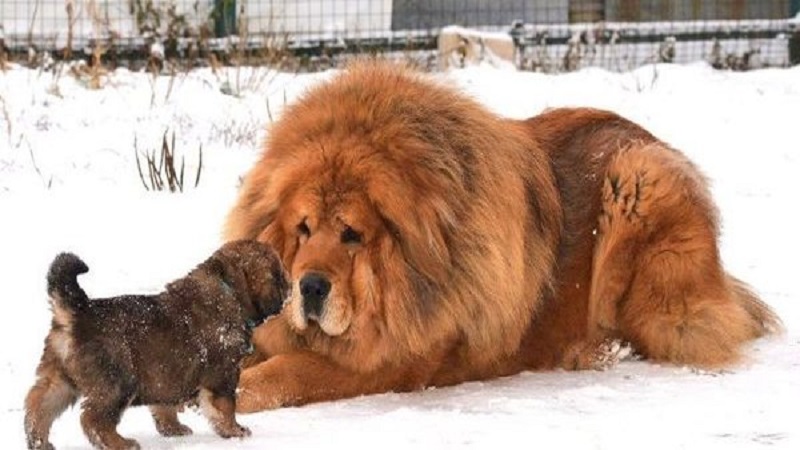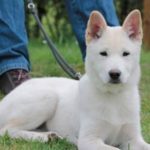The Tibetan Mastiff, also known as the Tibetan Hound, is an impressive breed with a formidable reputation. With their large stature and fierce loyalty, they have long been prized by the people of Tibet for their ability to protect livestock and their homes from wild animals such as wolves, tigers, and bears. Let’s delve into the world of these majestic canines.
1. Unveiling the Tibetan Mastiff
Origins of the Tibetan Mastiff
 The Tibetan Mastiff’s Origins
The Tibetan Mastiff’s Origins
Native to the high-altitude Tibetan Plateau in China, the Tibetan Mastiff is a colossal breed. Remarkably, this ancient breed has retained its pure genetics, remaining largely untouched by crossbreeding with other canine varieties.
Their value as gifts for royalty in the 19th century led to their widespread introduction to Europe. Today, their fame has spread across the Americas, particularly in the United States and Canada. However, their popularity and high price tag have led to extensive crossbreeding and commercialization. Purebred Tibetan Mastiffs of unadulterated lineage are now only found in the remote highlands of Tibet.
Common Coat Colors of the Tibetan Mastiff
 Coat Colors of the Tibetan Mastiff
Coat Colors of the Tibetan Mastiff
This giant breed sports a thick, double-layered coat that covers its entire body like a sturdy armor. Their coat colors typically feature a combination of black, golden, reddish-brown, gray, and brown hues.
Physical Characteristics of the Tibetan Mastiff
 Physical Traits of the Tibetan Mastiff
Physical Traits of the Tibetan Mastiff
The most striking feature of the Tibetan Mastiff is its imposing size, with males standing at 70-80 cm tall and weighing between 60-90 kg. Their thick coat further enhances their massive appearance. The double coat consists of a short and soft underlayer, while the outer layer is longer and coarser, resembling sheep’s wool. This adaptive feature allows them to withstand frigid temperatures.
Beneath all that fur lies a well-proportioned, muscular body. Their powerful legs provide stability and remarkable speed, even outpacing wolves. The chest, shoulders, and hips are also notably well-developed. A common saying describes the Tibetan Mastiff as “bigger than a wolf, stronger than a tiger, and faster than a deer.”
This breed boasts a large head, a drooping face, a wide mouth armed with sharp teeth capable of delivering a fatal bite, and slightly upward-slanted eyes that give them a keen and fierce expression.
Temperament of the Tibetan Mastiff
 The Fierce Nature of the Tibetan Mastiff
The Fierce Nature of the Tibetan Mastiff
Loyalty is the hallmark of the Tibetan Mastiff. They form an unbreakable bond with their caregiver and recognize only one master. These dogs will bravely fight and sacrifice themselves to protect their beloved owner.
Their wild nature makes them highly aggressive and potentially dangerous. Alongside the Presa Canario, the Tibetan Mastiff is considered one of the most dangerous dog breeds in the world. Their combination of agility, strength, and fierce temperament underscores the importance of proper training and handling to prevent them from becoming a liability.
Despite their formidable reputation, they are obedient and gentle with their owners, displaying a calm and friendly demeanor.
2. Caring for Your Tibetan Mastiff
Nutritional Requirements of the Tibetan Mastiff
To ensure the optimal development of your Tibetan Mastiff, it is crucial to provide a balanced diet rich in vitamins, minerals, and ample protein and calcium.
 Nutritional Needs of the Tibetan Mastiff
Nutritional Needs of the Tibetan Mastiff
Dietary Plan for Different Life Stages
Ages 2-4 months: For young Tibetan Mastiffs, a diet of rice and minced lean meat, along with other nutritious foods, is recommended. Feed them three meals a day.
Ages 4-8 months: As your puppy grows, increase their protein intake with foods like chicken breasts, organ meats, and duck necks. Incorporate vegetables, fruits, and dry food into their diet as well.
You can also offer large bones, such as beef leg bones or pork leg bones, for them to chew on. This helps strengthen their jaws and provides a source of calcium. However, avoid sharp bones like chicken or duck bones to prevent throat injuries. At this stage, you can reduce their meals to twice a day while increasing the portion size.
Ages 8-12 months: Ensure a steady supply of protein and calcium for their continued growth. Feed them tough meats like beef, mutton, or goat, along with a daily bone to chew on. Include eggs in their diet as well. You can offer one main meal and one smaller meal per day, with larger portion sizes.
Ages 1 year and above: These adult giants require a minimum of 1 kg of food per day. Supplement their diet with dry food, vegetables, and fruits for better digestion. Gradually increase their food intake according to their weight.
Grooming and Hygiene for the Tibetan Mastiff
 The Active Nature of the Tibetan Mastiff
The Active Nature of the Tibetan Mastiff
Given their Tibetan heritage, these dogs are accustomed to cold temperatures and require ample space to roam and exercise. Provide shade during hot weather, and on particularly warm days, allow them access to air-conditioned rooms.
The Vietnamese climate can make grooming a challenge. Regular trimming is essential to help them stay cool, especially during the summer months. Their dense coat also needs daily brushing to prevent tangles and maintain its smoothness. A wide-toothed comb is recommended due to their abundant fur.
Bathe your Tibetan Mastiff at least once a month to maintain hygiene. After bathing, be sure to dry their coat thoroughly using a hairdryer or by air-drying to prevent bacterial growth and skin infections. Additionally, regularly clean their eyes, nose, ears, paws, and teeth to ward off parasites.
Common Health Issues in Tibetan Mastiffs
Despite their robust build, Tibetan Mastiffs are susceptible to certain health conditions:
- Elbow Dysplasia: This condition is common in large breeds and can be caused by genetics, calcium deficiency, or overexertion. It results in loose joints and can lead to lameness.
- Infectious Tracheobronchitis: Puppies are particularly vulnerable to this condition if not kept warm enough. Symptoms include red and watery eyes, a dry nose, and persistent coughing. Early treatment is crucial to prevent chronic issues.
- Gastrointestinal Issues: Improper diet or lack of regular deworming can lead to gastrointestinal problems, manifested by loss of appetite, vomiting, and high fever.
Note: Regular deworming is essential to prevent gastrointestinal issues.
3. Purchasing a Tibetan Mastiff
Price Range of Tibetan Mastiffs
 Price Variations of Tibetan Mastiffs
Price Variations of Tibetan Mastiffs
While Tibetan Mastiffs have been successfully bred in Vietnam, their high price and aggressive nature limit their popularity. A two-month-old Tibetan Mastiff typically costs around 20-25 million VND. Older dogs command higher prices.
Importing a Tibetan Mastiff from Europe or America incurs a substantial cost, ranging from 8,000 to 10,000 USD (over 200 million VND).
A purebred Tibetan Mastiff imported directly from Tibet can fetch astronomical prices. You may have heard of Tibetan Mastiffs selling for billions of VND. These exorbitant prices reflect their pure genetics, impressive size, and limited availability.
Considerations When Buying a Tibetan Mastiff
The Tibetan Mastiff is a unique breed, and prospective owners should consider the following before purchasing one:
- Assess your financial capacity: Before shopping, determine how much you can afford to spend on a Tibetan Mastiff. This will help you make an informed decision.
- Beware of suspiciously low prices: The minimum price for this breed in Vietnam is already quite high, so be cautious of extremely low prices, as they are unlikely to be genuine Tibetan Mastiffs.
- Avoid following trends: Some people acquire Tibetan Mastiffs to keep up with trends or showcase their wealth. This is a serious mistake. Unlike other breeds, Tibetan Mastiffs are highly aggressive and stubborn, posing a potential danger if not properly trained and handled.
- Choose a reputable seller: To ensure you’re getting a genuine Tibetan Mastiff, purchase from a trusted source with transparent pricing.
We hope this comprehensive guide has enhanced your understanding of the Tibetan Mastiff, the world’s most expensive and dangerous dog breed.










